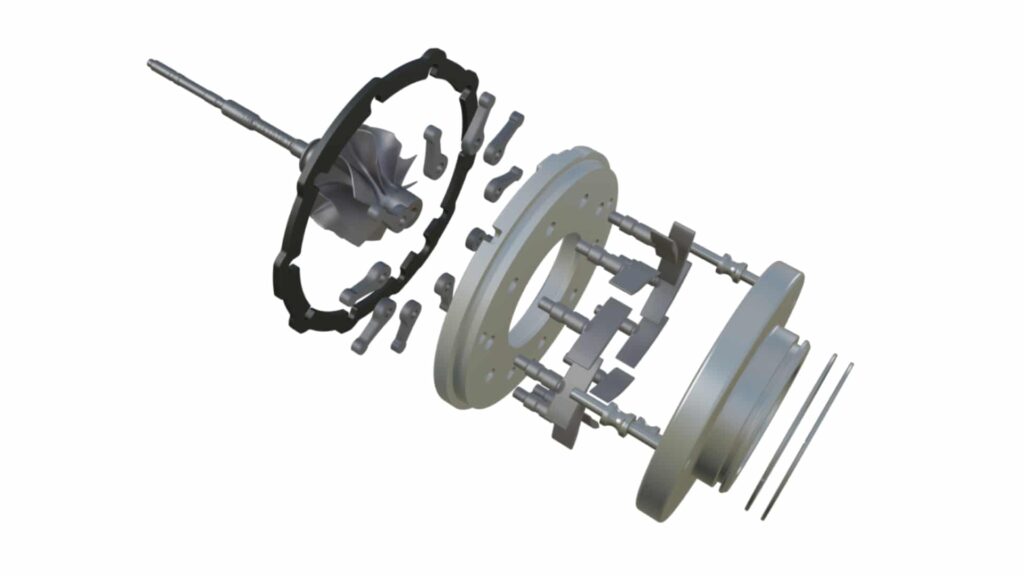 With over 50 million units in the field, Garrett Variable Geometry Turbo (VNT™) is a key variable geometry turbo technology for auto manufacturers as they seek to enhance light vehicle driveability, improve fuel efficiency and reduce emissions.
With over 50 million units in the field, Garrett Variable Geometry Turbo (VNT™) is a key variable geometry turbo technology for auto manufacturers as they seek to enhance light vehicle driveability, improve fuel efficiency and reduce emissions.
The latest generation VNT delivers benchmark transient response, low-speed efficiency, reliability, weight savings and packaging flexibility.
Engine range
Variable Geometry Turbo (VNT) technology, in a mono-turbo set-up, is ideally suited for diesel and gasoline engines from 0.9L to 3.0L. While the majority of VNT applications are in the 1.0L to 2.0L range, the architecture is also heavily specified in the 1.5L gasoline engine segment for high fuel efficiency and in the premium 3.0L V6 diesel segment for large vehicle (like SUVs) performance and economy.
Key Features
In a VNT turbo, the exhaust flow through the turbine wheel is controlled by a row of vanes that move to match the exact boost requirements of the engine. At low engine speed, the variable nozzle turbine vanes close to restrict the exhaust air flow through the turbine, thereby increasing turbine power and boost pressure. At higher engine speeds, the moveable vanes open to maximize the exhaust gas flow, thereby avoiding turbo over-speed and maintaining the boost pressure required by the engine.
The latest generation Garrett Variable Geometry (VNT) turbos for both gasoline and diesel applications have undergone continuous development and improvements in performance and reliability since the first mainstream diesel production launch in 1989. In particular, the key advance was the ground-breaking way that the variable mechanisms were attached onto the bearing housing through an elastic shroud concept. This new platform delivered many innovations – a new cartridge design, new cambered vanes, a new generation turbine wheel, improved aerodynamics, optimised controllability and better high temperature reliability.
Key Benefits
VNT turbos contribute to higher torque levels, particularly at low engine speed, and help deliver more power across a wider range, better acceleration through improved transient response and cleaner combustion. Lower emissions are made possible by Exhaust Gas Recirculation facilitated by the turbo.
VNT technology is also a key enabler of engine downsizing, an industry-wide trend to create smaller, more fuel-efficient and lower-emitting powertrains that match or exceed the performance of their larger counterparts and enhanced braking capability.The first high volume production gasoline VNT was launched with Volkswagen in 2017, and has undergone continuous improvement and upgrades for new generation gasoline engines since that time. Gasoline VNT is now applied to multiple engine applications with multiple customers across the globe, as the fuel economy and emissions targets globally become more challenging. Gasoline VNT technology is a key enabler to meet those new emissions regulations while maintaining the high performance and cost effectiveness of the overall boosting system.
Although launched more than 35 years ago on the 1.9L Fiat Croma, it was in 1995 that VNT, with a new vane design and improved aerodynamics, really came of age when matched to VW-Audi’s 1.9-liter direct injection diesel engine. Second generation VNT, launched three years later, offered greater controllability through new aerodynamics and electric actuation. Then came the 3rd Generation, launched on the BMW One Series with a new cartridge design, cambered vanes, new turbine wheel and improved aerodynamics… all combining to deliver 130 percent of Generation 2 boost at 90 percent of back pressure. The diesel VNT technology is now in its sixth generation, with continued upgrades and performance and reliability, and is still being applied as the customer preferred choice on many different diesel applications globally.y
Evolution and Future Trends
With its versatility in range and ever-improving capabilities, VNT will remain the leading turbo technology for diesel and gasoline engines for the foreseeable future. Garrett engineers are working on scale reduction to fit ever-smaller engines as automakers embrace the downsizing agenda, while at the same time it’s now also a key component in a number of complex two-stage turbocharging systems to deliver superior performance and great fuel efficiency. It’s also increasingly linked to 3 cylinder diesel and gasoline power units. It’s clear that the technology has a great future ahead of it, particularly with ongoing advances in aerodynamics, bearing systems and materials science.











